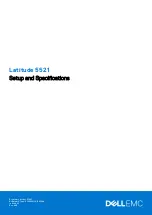
Chapter 25 xDSL Statistics
P-873HNU(P)-51B User’s Guide
232
The following table describes the labels in this screen.
Table 97
Status > xDSL Statistics
LABEL
DESCRIPTION
Refresh Interval
Select the time interval for refreshing statistics.
Line
Select which DSL line’s statistics you want to display.
xDSL Training
Status
This displays the current state of setting up the DSL connection.
Mode
This displays the ITU standard used for this connection.
Traffic Type
This displays the type of traffic the DSL port is sending and receiving. Inactive
displays if the DSL port is not currently sending or receiving traffic.
Link Uptime
This displays how long the port has been running (or connected) since the last
time it was started.
xDSL Port Details
Upstream
These are the statistics for the traffic direction going out from the port to the
service provider.
Downstream These are the statistics for the traffic direction coming into the port from the
service provider.
Line Rate
These are the data transfer rates at which the port is sending and receiving data.
Actual Net Data
Rate
These are the rates at which the port is sending and receiving the payload data
without transport layer protocol headers and traffic.
Trellis Coding
This displays whether or not the port is using Trellis coding for traffic it is sending
and receiving. Trellis coding helps to reduce the noise in ADSL transmissions.
Trellis may reduce throughput but it makes the connection more stable.
SNR Margin
This is the upstream and downstream Signal-to-Noise Ratio margin (in dB). A
DMT sub-carrier’s SNR is the ratio between the received signal power and the
received noise power. The signal-to-noise ratio margin is the maximum that the
received noise power could increase with the system still being able to meet its
transmission targets.
Actual Delay
This is the upstream and downstream interleave delay. It is the wait (in
milliseconds) that determines the size of a single block of data to be interleaved
(assembled) and then transmitted. Interleave delay is used when transmission
error correction (Reed- Solomon) is necessary due to a less than ideal telephone
line. The bigger the delay, the bigger the data block size, allowing better error
correction to be performed.
Transmit Power
This is the upstream and downstream far end actual aggregate transmit power (in
dBm).
Upstream is how much power the port is using to transmit to the service provider.
Downstream is how much port the service provider is using to transmit to the
port.
Receive Power
Upstream is how much power the service provider is receiving from the port.
Downstream is how much power the port is receiving from the service provider.
Actual INP
Sudden spikes in the line’s level of external noise (impulse noise) can cause errors
and result in lost packets. This could especially impact the quality of multimedia
traffic such as voice or video. Impulse noise protection (INP) provides a buffer to
allow for correction of errors caused by error correction to deal with this. The
number of DMT (Discrete Multi-Tone) symbols shows the level of impulse noise
protection for the upstream and downstream traffic. A higher symbol value
provides higher error correction capability, but it causes overhead and higher
delay which may increase error rates in received multimedia data.
Total Attenuation This is the upstream and downstream line attenuation, measured in decibels (dB).
This attenuation is the difference between the power transmitted at the near-end
and the power received at the far-end. Attenuation is affected by the channel
characteristics (wire gauge, quality, condition and length of the physical line).
Summary of Contents for P-873HNU-51B
Page 4: ...Contents Overview P 873HNU P 51B User s Guide 4...
Page 13: ...Table of Contents P 873HNU P 51B User s Guide 13 Appendix F Legal Information 329 Index 333...
Page 14: ...Table of Contents P 873HNU P 51B User s Guide 14...
Page 15: ...15 PART I User s Guide...
Page 16: ...16...
Page 32: ...Chapter 2 The Web Configurator P 873HNU P 51B User s Guide 32...
Page 57: ...57 PART II Technical Reference...
Page 58: ...58...
Page 64: ...Chapter 5 Network Map and Status Screens P 873HNU P 51B User s Guide 64...
Page 108: ...Chapter 7 Wireless P 873HNU P 51B User s Guide 108...
Page 132: ...Chapter 9 Static Routing P 873HNU P 51B User s Guide 132...
Page 152: ...Chapter 10 Quality of Service QoS P 873HNU P 51B User s Guide 152...
Page 168: ...Chapter 11 Network Address Translation NAT P 873HNU P 51B User s Guide 168...
Page 182: ...Chapter 13 IGMP P 873HNU P 51B User s Guide 182...
Page 188: ...Chapter 14 Interface Group P 873HNU P 51B User s Guide 188...
Page 202: ...Chapter 17 Parental Control P 873HNU P 51B User s Guide 202...
Page 224: ...Chapter 22 Logs P 873HNU P 51B User s Guide 224...
Page 234: ...Chapter 25 xDSL Statistics P 873HNU P 51B User s Guide 234...
Page 238: ...Chapter 26 Users Configuration P 873HNU P 51B User s Guide 238...
Page 244: ...Chapter 27 Remote Management P 873HNU P 51B User s Guide 244...
Page 250: ...Chapter 29 Logs Setting P 873HNU P 51B User s Guide 250...
Page 256: ...Chapter 31 Configuration P 873HNU P 51B User s Guide 256...
Page 262: ...Chapter 32 Diagnostic P 873HNU P 51B User s Guide 262...
Page 274: ...Chapter 34 Product Specifications P 873HNU P 51B User s Guide 274...
Page 310: ...Appendix C Pop up Windows JavaScript and Java Permissions P 873HNU P 51B User s Guide 310...
Page 324: ...Appendix D Wireless LANs P 873HNU P 51B User s Guide 324...
















































